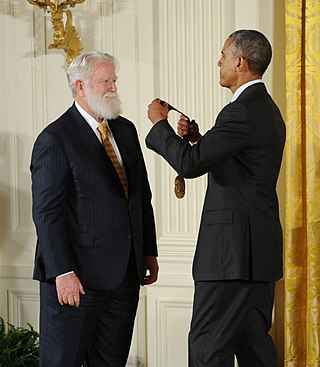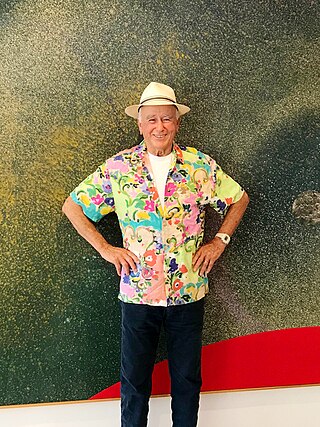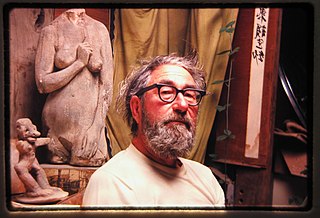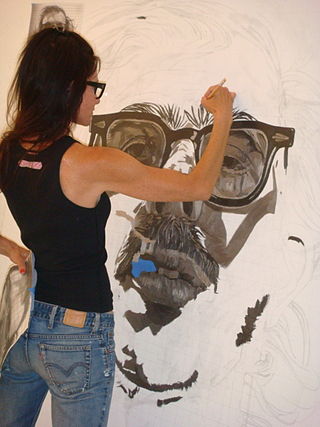Related Research Articles

Richard Diebenkorn was an American painter and printmaker. His early work is associated with abstract expressionism and the Bay Area Figurative Movement of the 1950s and 1960s. In the late 1960s he began his extensive series of geometric, lyrical abstract paintings. Known as the Ocean Park paintings, these paintings were instrumental to his achievement of worldwide acclaim.

Christian Liberté Boltanski was a French sculptor, photographer, painter, and film maker. He is best known for his photography installations and contemporary French conceptual style.
Edward Joseph Ruscha IV is an American artist associated with the pop art movement. He has worked in the media of painting, printmaking, drawing, photography, and film. He is also noted for creating several artist's books. Ruscha lives and works in Culver City, California.

James Turrell is an American artist known for his work within the Light and Space movement. He is considered the "master of light" often creating art installations that mix natural light with artificial color through openings in ceilings thereby transforming internal spaces by ever shifting and changing color.

John Rivers Coplans was a British artist, art writer, curator, and museum director. A veteran of World War II and a photographer, he emigrated to the United States in 1960 and had many exhibitions in Europe and North America. He was on the founding editorial staff of Artforum from 1962 to 1971, and was Editor-in-Chief from 1972 to 1977.

Marcia Tucker was an American art historian, art critic and curator. In 1977 she founded the New Museum of Contemporary Art, a museum dedicated to innovative art and artistic practice in New York City, which she ran as the director until 1999.

Ronald "Ron" Davis is an American painter whose work is associated with geometric abstraction, abstract illusionism, lyrical abstraction, hard-edge painting, shaped canvas painting, color field painting, and 3D computer graphics. He is a veteran of nearly seventy solo exhibitions and hundreds of group exhibitions.
The Ferus Gallery was a contemporary art gallery which operated from 1957 to 1966. In 1957, the gallery was located at 736-A North La Cienega Boulevard, Los Angeles in the U.S. state of California. In 1958, it was relocated across the street to 723 North La Cienega Boulevard where it remained until its closing in 1966.

Billy Al Bengston was an American visual artist and sculptor who lived and worked in Venice, California, and Honolulu, Hawaii. Bengston was probably best known for work he created that reflected California's "Kustom" car and motorcycle culture. He pioneered the use of sprayed layers of automobile lacquer in fine art and often used colors that were psychedelic and shapes that were mandala-like. ARTnews referred to Bengston as a "giant of Los Angeles's postwar art scene."
Gerald Jay Goldberg was an American author. He was a professor emeritus at the University of California, Los Angeles, where he taught English and American literature and Creative Writing. An acclaimed novelist, he was also a critic and the author of a nonfiction study of the network news and a biography of Ted Turner.

Twentysix Gasoline Stations is the first artist's book by the American pop artist Ed Ruscha. Published in April 1963 on his own imprint National Excelsior Press, it is often considered to be the first modern artist's book, and has become famous as a precursor and a major influence on the emerging artist's book culture, especially in America. The book delivers exactly what its title promises, reproducing 26 photographs of gasoline stations next to captions indicating their brand and location. From the first service station, 'Bob's Service' in Los Angeles where Ruscha lived, the book follows a journey back to Oklahoma City where he had grown up and where his mother still lived. The last image is of a Fina gasoline station in Groom, Texas, which Ruscha has suggested should be seen as the beginning of the return journey, 'like a coda'.
Ed Moses was an American artist based in Los Angeles and a central figure of postwar West Coast art.

Joseph T. Funk (c.1914–1981) was an American artist, printmaker, and educator. He was a sculptor, lithographer, and muralist. Funk worked as a master printmaker at Tamarind Lithography Workshop, Kanthos Press, and Joseph Press.

Alison Van Pelt is an American painter. Trained in Los Angeles and Florence, Van Pelt is established as a contemporary artist whose work is informed by expressionism, minimalism and pop art.

Peter Plagens is an American artist, art critic, and novelist based in New York City. He is most widely known for his longstanding contributions to Artforum and Newsweek, and for what critics have called a remarkably consistent, five-decade-long body of abstract formalist painting. Plagens has written three books on art, Bruce Nauman: The True Artist (2014), Moonlight Blues: An Artist's Art Criticism (1986) and Sunshine Muse: Modern Art on the West Coast, 1945-70 (1974), and two novels, The Art Critic (2008) and Time for Robo (1999). He has been awarded major fellowships for both his painting and his writing. Plagens's work has been featured in surveys at the Museum of Modern Art, Los Angeles County Museum of Art (LACMA), Whitney Museum, and PS1, and in solo exhibitions at the Hirshhorn Museum and Las Vegas Art Museum. In 2004, the USC Fisher Gallery organized and held a 30-year traveling retrospective of his work. Critics have contrasted the purely visual dialogue his art creates—often generating more questions than answers—with the directness of his writing; they also contend that the visibility of his bylines as a critic has sometimes overshadowed his artmaking—unduly. Los Angeles Times critic David Pagel described Plagens's painting as a "fusion of high-flying refinement and everyday awkwardness" with an intellectual savvy, disdain for snobbery and ungainliness he likened to Willem de Kooning's work. Reviewing Plagens's 2018 exhibition, New York Times critic Roberta Smith called the show an "eye-teasing sandwich of contrasting formalist strategies," the hard-won result of a decade of focused experimentation.

Kristine McKenna is an American journalist, critic and art curator best known for her interviews with artists, writers, thinkers, filmmakers and musicians. Many of these have been collected in Book of Changes (2001) and Talk to Her (2004). Among the people she has interviewed and written about most often over the years are Exene Cervenka, Leonard Cohen, David Lynch, Captain Beefheart, Brian Eno and Dan Hicks.
Joan Nelson is a visual artist who lives and works in upstate New York. For over three decades, Nelson has been making "epic and theatrical landscape paintings," borrowing from art history and re-presenting iconic vistas from the Fine Art lexicon including those of the Hudson River and Mount Hood. Joan Nelson spent her youth in St. Louis, Missouri, and "emerged from the East Village in the mid-‘80s at the forefront of a landscape revival that blurred the line between romance and irony.” Now, as then, Nelson paints small paintings on thick pieces of wood using a variety of materials such as oil paint and glitter, often combined with wax. She is well known for incorporating multiple pictorial landscape traditions in her vistas, combining fragments of paintings by other artists including those of artists: Hergé, who illustrated Tintin, Albrecht Altdorfer, Albert Bierstadt, Edward Hicks, Caspar David Friedrich, and George Caleb Bingham. This "referential vocabulary" demonstrates that Nelson's "landscape painting is not about the imitation of nature, or verisimilitude, but about art.” Occupying a unique place in the long history of landscape painting, Nelson "speaks to the experience of nature and the complexity of its representation across time and place... one that is distinctly female and revisionist." Her work has been described as "apocalyptic, with critics uncertain whether she is showing us an end or a potential beginning."
Caroline A. Jones, is an American art historian, author, curator, and critic. She teaches and serves within the History Theory Criticism Section of the Department of Architecture at MIT School of Architecture and Planning, Cambridge, Massachusetts, United States.

Gloria Kisch (1941–2014) was an American artist and sculptor known especially for her early post-Minimalist paintings and wall sculptures, and her later large-scale work in metal.
Gerald Nordland (1927–2019) was an American museum director and art critic.
References
- ↑ Nancy Marmer's entry in Marquis Who's Who in America, 1997 to the present.
- ↑ Masthead of Art in America from May/June 1979 to May 2008.
- ↑ Masthead of Artforum, 1976-77.
- ↑ Masthead of Art International, 1965-67.
- ↑ "News and Notes," Critique: Studies in Modern Fiction, Vol. 1, Issue 1, 1956, p.2; "An Afterword: Celebrating Twenty Volumes," Critique: Studies in Contemporary Fiction, Vol. 21, Issue 1, 1979, pp. 102-104.
- ↑ "Introduction," Pacific Standard Time: Los Angeles Art 1945-1980, ed. Rebecca Peabody, Andrew Perchuk, Glenn Phillips, Rani Singh, The Getty Research Institute, 2011, p. 1 and passim.
- ↑ Mike Davis, City of Quartz: Excavating the Future in Los Angeles , 1990 , Verso (new edition), 2006, p. 65.
- ↑ Marmer's review, "Edward Ruscha at Ferus," Artforum, December 1964, is listed as Ruscha's "first significant national exposure" in the artist's online chronology, http://www.edruscha.com.
- ↑ "Richard Diebenkorn: Pacific Extensions," Art in America, January/February 1978, pp. 95-99.
- ↑ "James Turrell: The Art of Deception," Art in America, May 1981, pp.90-99.
- ↑ "Ron Davis: Beyond Flatness," Artforum, November 1976, pp. 34-37.
- ↑ "Ed Moses' Absolutist Abstractions," Art in America, November/December 1976, pp. 94-95.
- ↑ "Alexis Smith" The Narrative Act," Artforum, December 1976, pp. 31-33.
- ↑ Chapter 3 of Pop Art, ed. Lucy R. Lippard, Frederick Praeger, New York, 1966, pp. 139-161. (Other editions: Uitgeverij W. Gaade, Den Haag, 1966; Thames and Hudson, London, 1966; Gabriele Mazzotta Editore, Milano, 1967; Fernand Hazan Editeur, Paris, 1969; Droemer Knauer, 1969, etc. Reissued by Oxford University Press, 1977).
- ↑ Paul Schimmel, Under the Big Black Sun: California Pluralism and the Birth of the Postmodern Movement, MOCA, Oct. 1, 2011-Feb. 13, 2012.
- ↑ "Christian Boltanski: The Uses of Contradiction," Art in America, October 1989, pp. 168-181, 233-235. Described as "one of the best critical accounts of the context and development of Boltanski's work in Postmodernism and the Re-reading of Modernity, Manchester University Press, 1992, p. 114.
- ↑ "Waiting for Gloire: Beaubourg Opens in Paris," Artforum, February 1977, pp. 52-59.
- ↑ "The New Culture: France '82," Art in America, December 1982, pp. 115-123, 181-189; Referred to in Andreas Kupfer Schneider, Creating the Musee d'Orsay: The Politics of Culture in France, Pennsylvania University Press, 1998, p. 14.
- ↑ Prentice-Hall, Englewood Cliffs, N.J., 1962.
- ↑ "Home". exegette.blogspot.com.